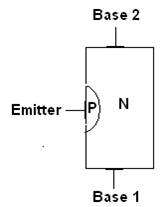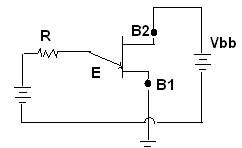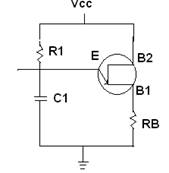UJT - Uni Junction Transistor
The term UJT stands for Uni Junction Transistor. This type of transistor possesses one PN junction and three terminals. As shown in the below figure.
Construction of UJT
The UJT is consist of a light-doped N-Type silicon bar, there is a heavily doped P-Type region at one side of the N-Type bar. The terminal which is connected to the P-Type region is called the emitter terminal (E), while the other two terminals which are connected to the opposite ends of the N-Type bar are called Base 1, Base 2 (B1, B2) as shown in the Figure below.

Biasing of the UJT - Uni Junction Transistor
The Uni Junction Transistor is always operating with forward bias voltages. For this purpose, the Emitter Base 1 Junction is always kept forward bias w.r.t Base 2.
Operation / Working of UJT
When the voltage between the emitter and Base 1 is zero, the Uni Junction Transistor did not conduct and so the N-Type bar acts as a resistor. But we will see that a small leakage current flows due to reverse bias junction. Now when we increase the emitter voltage step by step, the resistance between the emitter and base 1 decrease, and also the reverse current decreases, when the emitter voltage is increased to the level that it forward bias the junction and the emitter current start to flow. It is so because the holes of the heavily doped P-Type region are entered in the N-Type bar and recombined with the electrons of the lightly doped N-Type bar. In this way, the Uni Junction Transistor starts conducting.

Applications of UJT
The Uni Junction Transistor can be used as a triggering device for SCR and TRAIC, The other application of the Uni Junction Transistor is saw tooth wave generator, Phase control, and in timing circuits.
UJT as Relaxation Oscillator
the given circuit shows that the UJT - Uni Junction Transistor can be used as a relaxation oscillator. It consists of a UJT - Uni Junction Transistor, resistor, capacitor, and base resistor.
When we switch ON the circuit the DC biasing voltage is applied to the circuit. The capacitor “C” charges to its peak value through the resistor “R”, when the capacitor is charged, it triggers the Uni Junction Transistor and so the Uni Junction Transistor starts conducting. In this way, the capacitor “C” discharges through the base resistor “RB”. Now when the capacitor is discharged, it starts to charge again through the resistor “R” and similarly it will discharge when it triggers the Uni Junction Transistor, so the capacitor charging and discharging takes place and we get a sawtooth wave, as shown in the below Figure.


